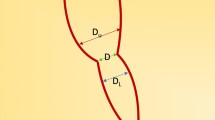Abstract
Background
Radiographic assessment of esophageal growth in long-gap esophageal atresia while on traction and associated traction-related complications have not been described.
Objective
To demonstrate how chest radiography can estimate esophageal position while on traction and to evaluate radiography’s utility in diagnosing certain traction system complications.
Materials and methods
In this retrospective evaluation of portable chest radiographs obtained in infants with long-gap esophageal atresia who underwent the Foker process between 2014 and 2020, we assessed distances between the opposing trailing clips (esophageal gap) and the leading and trailing clips for each esophageal segment on serial radiographs. Growth during traction was estimated using longitudinal random-effects regression analysis to account for multiple chest radiograph measurements from the same child.
Results
Forty-three infants (25 male) had a median esophageal gap of 4.5 cm. Median traction time was 14 days. Median daily radiographic esophageal growth rate for both segments was 2.2 mm and median cumulative growth was 23.6 mm. Traction-related complications occurred in 13 (30%) children with median time of 8 days from traction initiation. Daily change >12% in leading-to trailing clip distance demonstrated 86% sensitivity and 92% specificity for indicating traction-related complications (area under the curve [AUC] 0.853). Cumulative change >30% in leading- to trailing-clip distance during traction was 85% sensitive and 85% specific for indicating traction complications (AUC 0.874).
Conclusion
Portable chest radiograph measurements can serve as a quantitative surrogate for esophageal segment position in long-gap esophageal atresia. An increase of >12% between two sequential chest radiographs or >30% increase over the traction period in leading- to trailing-clip distance is highly associated with traction system complications.








Similar content being viewed by others
References
Nassar N, Leoncini E, Amar E et al (2012) Prevalence of esophageal atresia among 18 international birth defects surveillance programs. Birth Defects Res 94:893–899
Shieh HF, Jennings RW (2017) Long-gap esophageal atresia. Semin Pediatr Surg 26:72–77
Fullington NM, Potanos KM, Cauley RP et al (2016) Strain induced esophageal growth in a novel rodent model. J Pediatr Surg 51:1273–1278
Inoue S, Kosaka T, Takatsuki M et al (2015) Histological study of the elongated esophagus in a rat model. J Surg Res 195:495–501
Lopes MF, Catré D, Cabrita A et al (2008) Effect of traction sutures in the distal esophagus of the rat: a model for esophageal elongation by Foker’s method. Dis Esophagus 21:570–573
Foker J, Linden BC, Boyle EM, Marquardt C (1997) True primary repair for the full spectrum of esophageal atresia. Ann Surg 226:533–543
Bairdain S, Hamilton TE, Smithers CJ et al (2015) Foker process for the correction of long gap esophageal atresia: primary treatment versus secondary treatment after prior esophageal surgery. J Pediatr Surg 50:933–937
Svetanoff WJ, Zendejas B, Hernandez K et al (2021) Contemporary outcomes of the Foker process and evolution of treatment algorithms for long-gap esophageal atresia. J Pediatr Surg. https://doi.org/10.1016/j.jpedsurg.2021.02.054
Liszewski MC, Bairdain S, Buonomo C et al (2014) Imaging of long gap esophageal atresia and the Foker process: expected findings and complications. Pediatr Radiol 44:467–475
Vittinghoff E, Glidden D, Shiboski S, McCulloch C (2012) Regression methods in biostatistics: linear, logistic, survival, and repeated measures models, 2nd edn. Springer, New York
Hanley J, McNeil B (1982) The meaning and use of the area under a receiver operating characteristic (ROC) curve. Radiology 143:29–36
Shrout P, Fleiss J (1979) Intraclass correlations: uses in assessing rater reliability. Psychol Bull 98:420–428
Baird R, Lal DR, Ricca RL et al (2019) Management of long gap esophageal atresia: a systematic review and evidence-based guidelines from the APSA outcomes and evidence based practice committee. J Pediatr Surg 54:675–687
Acknowledgments
Dr. Alexandra M. Foust and Dr. Benjamin Zendejas contributed equally to this manuscript. Dr. Thomas E. Hamilton and Dr. Michael J. Callahan contributed equally as senior authors to this manuscript.
Author information
Authors and Affiliations
Corresponding author
Ethics declarations
Conflicts of interest
None
Additional information
Publisher’s note
Springer Nature remains neutral with regard to jurisdictional claims in published maps and institutional affiliations.
Rights and permissions
About this article
Cite this article
Foust, A.M., Zendejas, B., Mohammed, S. et al. Radiographic assessment of traction-induced esophageal growth and traction-related complications of the Foker process for treatment of long-gap esophageal atresia. Pediatr Radiol 52, 468–476 (2022). https://doi.org/10.1007/s00247-021-05228-z
Received:
Revised:
Accepted:
Published:
Issue Date:
DOI: https://doi.org/10.1007/s00247-021-05228-z




